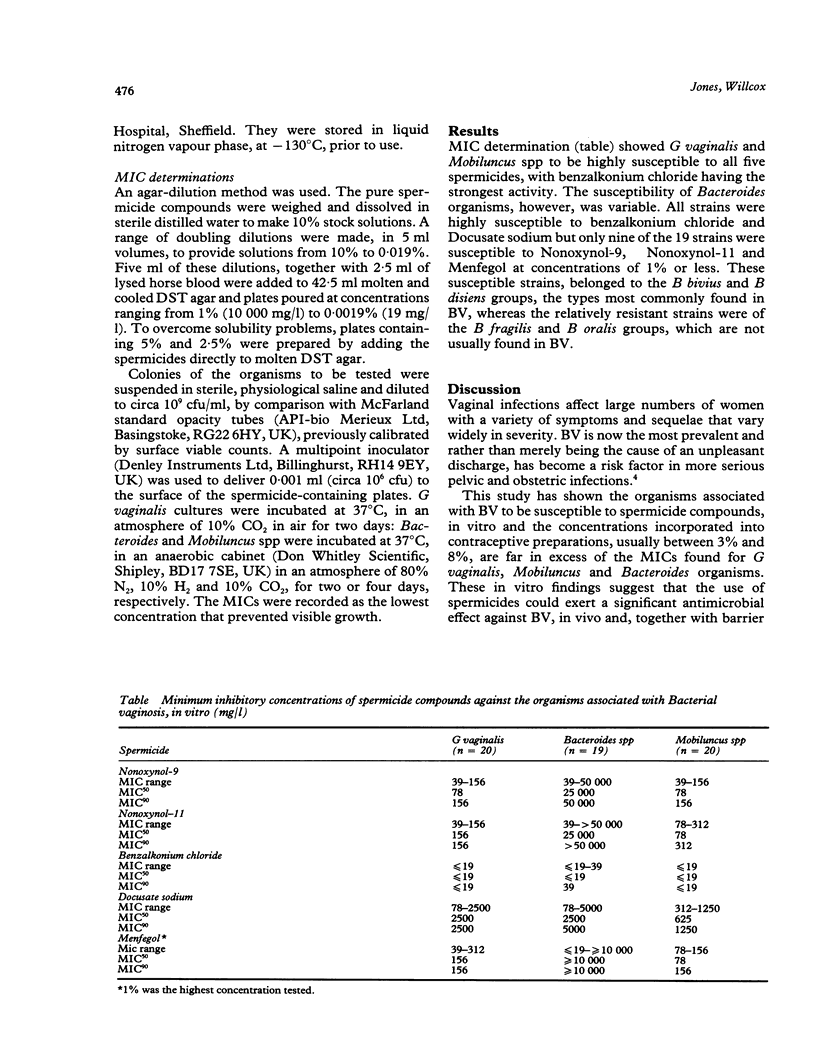Abstract
OBJECTIVES--Bacterial vaginosis (BV) is a prevalent vaginal infection that is now regarded as a risk factor in more serious pelvic and obstetric complications. Spermicides are known to have antimicrobial activity against other sexually transmitted diseases and the aim of this study was to test whether the causative organisms of BV were also susceptible to spermicides, in vitro. DESIGN--Minimal Inhibitory Concentrations of five spermicidal compounds were determined for the organisms associated with BV, in an agar dilution technique. LOCATION--The Department of Experimental and Clinical Microbiology, University of Sheffield Medical School, UK. SPERMICIDES AND ORGANISMS--Nonoxynol-9, Nonoxynol-11, Docusate sodium, Benzalkonium chloride and Menfegol were tested against 20 strains each of Gardnerella vaginalis, Bacteroides and Mobiluncus organisms, isolated from patients with BV who attended the Department of Genitourinary Medicine, the Royal Hallamshire Hospital, Sheffield. MAIN OUTCOME MEASURES--The susceptibility of BV-associated organisms to spermicidal compounds, in vitro. RESULTS--G vaginalis, Mobiluncus spp, Bacteroides bivius and Bacteroides disiens were all susceptible to the five spermicides tested, with MICs ranging between less than or equal to 19 and 5000 mg/l (0.0019%-0.5%). CONCLUSION--The concentrations of spermicides incorporated in contraceptive preparations are usually between 3% and 8%, which are far in excess of the MICs found for BV organisms. Their usage could exert a significant antimicrobial effect and be a useful prophylactic in preventing the infection.
Full text
PDF


Selected References
These references are in PubMed. This may not be the complete list of references from this article.
- Bramley H. M., Dixon R. A., Jones B. M. Haemophilus vaginalis (Corynebacterium vaginale, Gardnerella vaginalis) in a family planning clinic population. Br J Vener Dis. 1981 Feb;57(1):62–66. doi: 10.1136/sti.57.1.62. [DOI] [PMC free article] [PubMed] [Google Scholar]
- Feldblum P. J., Fortney J. A. Condoms, spermicides, and the transmission of human immunodeficiency virus: a review of the literature. Am J Public Health. 1988 Jan;78(1):52–54. doi: 10.2105/ajph.78.1.52. [DOI] [PMC free article] [PubMed] [Google Scholar]
- Jones B. M., Geary I., Lee M. E., Duerden B. I. Susceptibility of Haemophilus ducreyi to spermicidal compounds, in vitro. Genitourin Med. 1991 Jun;67(3):268–269. doi: 10.1136/sti.67.3.268-a. [DOI] [PMC free article] [PubMed] [Google Scholar]
- Judson F. N., Ehret J. M., Bodin G. F., Levin M. J., Rietmeijer C. A. In vitro evaluations of condoms with and without nonoxynol 9 as physical and chemical barriers against Chlamydia trachomatis, herpes simplex virus type 2, and human immunodeficiency virus. Sex Transm Dis. 1989 Apr-Jun;16(2):51–56. doi: 10.1097/00007435-198904000-00001. [DOI] [PubMed] [Google Scholar]
- Swedberg J. A. Bacterial vaginosis: etiology, association with preterm labor, diagnosis, and management. Compr Ther. 1989 Aug;15(8):47–53. [PubMed] [Google Scholar]


